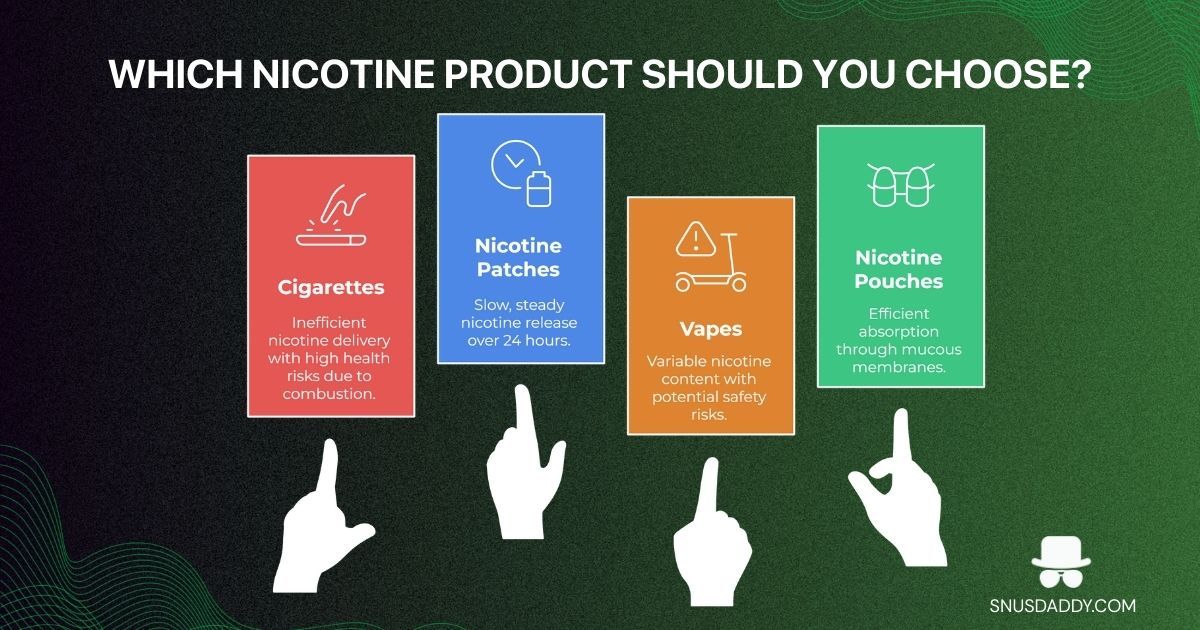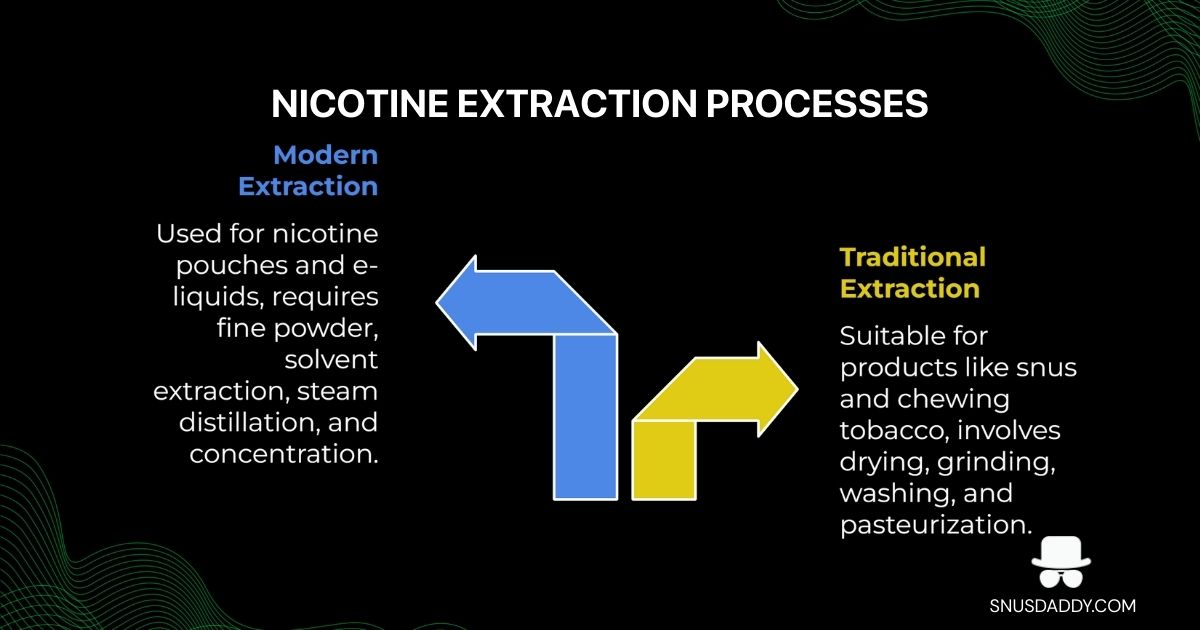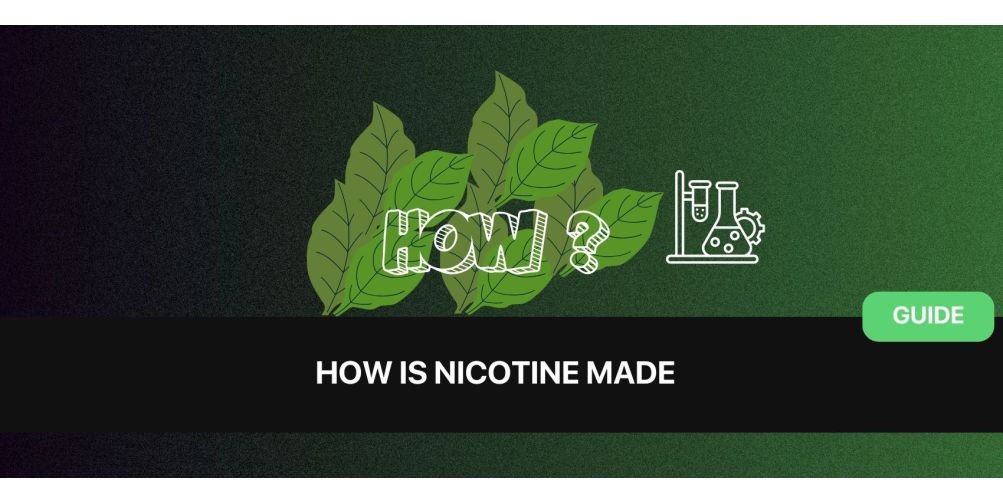Nicotine comes from the tobacco plant (Nicotiana tabacum), where it's naturally produced in the roots and stored in the leaves at concentrations of 0.6-3% by weight. Manufacturers then extract this alkaloid using steam distillation or chemical solvents to create everything from nicotine pouches to patches and e-liquids.
So beyond just knowing that nicotine is extracted from tobacco, what else should you understand about this stuff? A lot, actually, and this guide will delve deeper into the original and extraction process of nicotine. It will also address the different toxicity levels of different nicotine products to help you decide which one's best for you.
Cool? Cool.
Table Of Contents
What Is Nicotine & Where Does It Come From Naturally?
Let's start with the chemistry, but don't worry, we'll keep it simple. Nicotine's chemical composition includes 10 carbon atoms, 14 hydrogen atoms, and 2 nitrogen atoms (C10H14N2) arranged in what chemists call pyridine and pyrrolidine rings.
If that sounds like gibberish, just think of it as nature's way of building a molecule that happens to fit perfectly into receptors in your brain. It's kind of like how a key fits into a lock, except this particular key makes your brain release dopamine and other feel-good chemicals.
Primary Source of Nicotine
Now, let's talk about where nicotine comes from, which is from tobacco leaf harvested from...you guessed it, tobacco plants. These plants specifically are varieties in the Nicotiana tabacum from the Solanaceae family (the nightshade family).
These plants originally grew wild in South America, Africa, and Australia, and they've been cultivated for centuries because their leaves pack a serious nicotine punch. We're talking about 0.6-3% nicotine content by weight, which is way higher than any other plant in the nightshade family.
However, not all nicotine comes from these plants. Over time, farmers learned how to grow different types of tobacco depending on what the final product needs to be. For example, Virginia tobacco (also called flue-cured tobacco) and Burley tobacco are two of the most common varieties used in cigarettes and smokeless tobacco products, while other strains are specifically cultivated for nicotine extraction.
Original Purpose of Nicotine
Here's something interesting: plants didn't evolve to produce nicotine just so humans could get a buzz. The real evolutionary purpose was insect defense. When bugs try to munch on tobacco leaves, the nicotine acts as a natural pesticide. It's the plant's way of saying "back off" to anything trying to eat it. Pretty clever, right?
Nicotine In Everyday Food
Another factoid to sink your teeth into, literally: there are food (particularly nightshade family includes some vegetables)you probably eat regularly that contain nicotine. Here's how much nicotine is found in common foods:
- Tomatoes: About 332 nanograms each
- Potatoes: Roughly 675 nanograms each
- Eggplants: Around 525 nanograms each
Now, before you start thinking your pasta sauce is giving you a nicotine buzz, let's put this in perspective. Most people consume about 1,400 nanograms of nicotine daily just from eating normal food. That sounds like a lot until you realize that a single cigarette contains about 12 milligrams of nicotine. Do the math: that's 12,000,000 nanograms. In other words, a cigarette has roughly 18,000 times more nicotine than a potato.
This comparison is actually pretty important because it shows that nicotine itself isn't some scary toxic substance at normal dietary levels. Your body handles tiny amounts of nicotine from food just fine.
The difference comes down to concentration and delivery method. When you use tobacco products or nicotine pouches, you're getting a concentrated dose that's specifically designed to reach your brain and trigger those nicotinic receptors we mentioned earlier.
What About Synthetic Nicotine?
Here's where things get modern. Not all nicotine comes from tobacco anymore. Scientists figured out how to make nicotine in a lab without using any tobacco plant material at all.
This synthetic nicotine is chemically identical to natural nicotine extracted from tobacco, same C10H14N2 formula, same molecular structure, same effects on your body. The only difference is the source.
Some newer nicotine pouches and vaping products use this tobacco-free nicotine, which is appealing to people who want to avoid anything connected to traditional tobacco cultivation. Whether it's extracted from tobacco or made in a lab, though, nicotine is still nicotine. Your brain can't tell the difference.
Nicotine Content: How Much Is in Each Product?
When it comes to nicotine content, not all products are created equal. You might be surprised to learn that the amount of nicotine in a product doesn't always match what your body actually absorbs.

This is one of those things that trips people up when they're trying to switch from cigarettes to nicotine pouches or other nicotine replacement therapy options. They think, "okay, my cigarette has 12mg, so I need a 12mg pouch," but that's not quite how it works.
Let's break down the actual numbers so you can make smarter choices.
| Product Type | Total Nicotine Content | What Your Body Actually Absorbs |
|---|---|---|
| Cigarette | 10-30mg | 1-6mg (only 5-20% absorbed) |
| Cigar | 15-40mg | 1-8mg (5-20% absorbed) |
| Chewing tobacco (1 gram) | 6-8mg | 3-5mg |
| Nicotine gum | 2-4mg | 1-2mg |
| Nicotine patches | 8-100mg | 7-21mg delivered over 24 hours |
| E-liquid vial (5ml) | 0-100mg | Varies by usage |
| Nicotine pouches | 3-20mg | 1-12mg |
Let's talk about why these numbers matter.
Cigarettes
Cigarettes are incredibly wasteful nicotine delivery systems. The majority of nicotine in tobacco products like cigarettes never makes it into your body, as it just burns away.
When tobacco is burned in a cigarette, something like 80-95% of the nicotine content just drifts away as sidestream smoke. That's the smoke that curls up from the end of your cigarette between puffs. Your lungs only get a fraction of what's actually in there. This is why smokers often feel like they need to light up frequently to maintain their nicotine levels.
Not to mention, the combustion from burned tobacco creates 7,000+ chemicals including 69 known carcinogens. The health risks from cigarette smoking come from tobacco smoke (tar, carbon monoxide, formaldehyde), not primarily from nicotine itself. You probably already know this, but it's still something to think about.
Nicotine Patches
Nicotine patches work on a completely different principle than cigarettes. They are loaded with nicotine (as high as 100mg), but they're designed to deliver it slowly through your skin over an entire day. Even after wearing a patch for 24 hours, a good chunk of that nicotine is still sitting in the patch unused.
The slow, steady release is the whole point with patches: they're trying to give you a constant baseline of nicotine without the peaks and valleys you get from smoking.
Vapes
E-liquids for vaping are where things get a bit wild. These bottles can contain anywhere from zero nicotine up to 100mg in a 5ml container. That's a massive range, and it's one reason why proper handling is so important.
Unlike cigarettes where the nicotine is locked up in tobacco leaf and burns predictably, e-liquids are pure concentrated nicotine extract mixed with carriers. If a kid or pet gets into a bottle of high-concentration e-liquid, it's a serious medical emergency.
For this reason alone, some would say that nicotine pouches are better than vaping. Speaking of which...
Nicotine Pouches
Nicotine pouches (the reason most of you are probably reading this) typically range from 3mg on the light end up to 20mg for extra-strong varieties. What makes pouches interesting is the absorption rate. When you tuck a pouch between your gum and lip, the nicotine is absorbed through your mouth's mucous membranes. This is more efficient than smoking but slower than vaping. You'll typically absorb anywhere from 1-12mg depending on the pouch strength and how long you keep it in.
What Do These All Mean?
The type of nicotine product you choose should match your needs and experience level. Someone trying to quit smoking might start with higher-dose nicotine replacement options like strong pouches or patches, while someone who smoked occasionally might do fine with 3-6mg pouches. The amount of nicotine that works for one person might be too much or too little for another.
One more thing worth mentioning: different forms of nicotine have different onset times, which affects how satisfying they feel. Just know that nicotine content is only part of the equation. How fast that nicotine reaches your brain matters as much as the total dosage.
How Is Nicotine Extracted From Tobacco Leaves?
The nicotine extraction process differs from traditional products and more modern ones. Let's take a lot at both below.

Traditional Nicotine Extraction
Here's how the process works for products like snus and chewing tobacco:
-
Harvest and dry the tobacco leaves. Fresh leaves contain moisture that needs to be removed. Depending on the type of tobacco, this might involve air-curing, flue-curing, or sun-curing. The drying method affects the final flavor and chemical composition.
-
Grind the dried tobacco. The leaves get pulverized into increasingly fine powder. Think of it like grinding coffee beans, except the goal is to maximize surface area so the nicotine can be extracted more efficiently.
-
Wash and clean. This step removes dirt, debris, and some of the less desirable compounds that might affect flavor or quality. It's basically giving the tobacco a bath before the real work begins.
-
Pasteurization. For traditional products like snus, manufacturers pasteurize the ground tobacco. This process used to take weeks or even months, but modern techniques have sped things up considerably. Pasteurization kills bacteria and mellows out some of the harsher flavors.
Modern Extraction Process
For nicotine pouches or e-liquids, the process gets more sophisticated because you need to extract nicotine from tobacco and concentrate it to much higher purity levels. This is where the nicotine extraction process really kicks into high gear.
-
Create fine tobacco powder. We're talking really fine here, almost dust-like. The smaller the particles, the more efficiently you can extract nicotine from tobacco leaves.
-
Chemical extraction using solvents. This is where things get industrial. Manufacturers use solvents like methanol or ethanol to dissolve the nicotine out of the tobacco. Think of it like making coffee, except instead of water pulling caffeine from coffee grounds, you're using alcohol-based solvents to pull nicotine from tobacco. The solvent binds to the nicotine molecules and carries them away from the plant matter.
-
Steam distillation refinement. Once you've got nicotine dissolved in your solvent, you need to separate them. Steam distillation heats the mixture, causing the nicotine to vaporize at a different temperature than the solvent. The nicotine vapor is then collected and condensed back into liquid form. This is an old-school chemistry technique that's been used for centuries to purify all sorts of compounds.
-
Concentration to pharmaceutical grade. The goal is to get nicotine purity up to 99% or higher. This involves repeated refinement cycles, filtering out impurities, and testing to ensure consistency. The nicotine extract at this stage is extremely concentrated and requires careful handling.
-
Convert to final form. For nicotine pouches, the purified nicotine gets converted into a powder and mixed with plant fibers, pH adjusters, and flavorings. For e-liquids, it stays in liquid form and gets mixed with propylene glycol, vegetable glycerin, and flavor compounds.
Should I Try Extract Extracting Nicotine from Tobacco at Home?
No. I'm serious.
This isn't like making homemade soap or brewing beer. The chemicals involved (methanol, ethanol, and other solvents) are dangerous without proper ventilation and safety equipment. Concentrated nicotine extract is highly toxic if you get it on your skin or ingest it accidentally even in doses as small as a few drops. Industrial facilities have safety protocols, protective equipment, and proper disposal systems. Your kitchen does not.
So, leave the nicotine extraction to the professionals who know what they're doing. Instead, focus on what nicotine product to choose from that'll allow you to enjoy nicotine responsibly. Thankfully, it's what our next section's about!
How to Choose Between Cigarettes, Snus, and Nicotine Pouches
If you're trying to figure out which nicotine product makes sense for you, the answer depends on different factors which well discuss later.
But if you want a quick answer, here it goes:
Choose nicotine pouches for the cleanest tobacco-free option with controlled dosing and traditional snus for tobacco authenticity with reduced risk.
Now, here's how the main options stack up:
| Product | Nicotine Delivery Speed | Harm Level vs Cigarettes | Contains Tobacco? | Best For |
|---|---|---|---|---|
| Cigarettes | 10 seconds | Baseline (highest risk) | Yes | Nobody - switch to alternatives |
| Snus | 10-15 minutes | 90% less harmful | Yes | Those who want tobacco authenticity without smoke |
| Nicotine Pouches | 5-10 minutes | 95% less harmful | No | Anyone quitting smoking or wanting cleanest option |
| Vaping | 10-20 seconds | 95% less harmful | No | Those who miss the inhaling ritual |
| Patches/Gum | 20-60 minutes | Minimal risk | No | Smoking cessation with gradual reduction |
Looking at the table above, traditional snus and nicotine pouches compare favorably because both are smokeless nicotine alternatives.
The difference? Traditional snus contains tobacco leaf, meaning you're exposed to tobacco alkaloids beyond just nicotine. It requires occasional spitting and has a distinct tobacco taste.
Nicotine pouches, on the other hand remove the tobacco entirely, using either nicotine extracted from tobacco or synthetic nicotine made in labs. This means no tobacco-specific compounds, no spitting required, and cleaner flavor options.
To help you better decide which among these products you should use, here's an article where we compare nicotine pouches and patches or gum. Here's another where we pit VELO (a popular nicotine brand) against cigarettes.
NOTE: While we're not in any position to not use any of the nicotine products, people below should avoid them at all costs for health reasons:
- People with heart conditions, severe hypertension, or diabetes (nicotine increases heart rate and blood pressure)
- Pregnant or nursing women (nicotine affects fetal development)
- Anyone under 21 (or 18 in some regions)
How is Nicotine Made FAQs
What's the difference between flue-cured and burley tobacco?
The main difference between flue-cured and burley tobacco is the curing method and nicotine profile. Flue-cured (Virginia) tobacco is dried with indirect heat, preserving sugars and producing a milder flavor. Burley tobacco is air-cured, which removes more sugars and results in a stronger, drier smoke with lower sugar content .
Is nicotine from different tobacco plants chemically identical?
Yes, nicotine from different tobacco plants is chemically identical. Whether extracted from Nicotiana tabacum or synthesized in a lab, it maintains the same chemical formula, C10H14N2, and molecular structure, producing the same effects on the body .
How long does it take tobacco plants to produce harvestable nicotine?
Tobacco plants typically take 8–10 weeks after transplanting to produce harvestable nicotine. During this period, nicotine accumulates in the leaves, peaking when the plant is mature and ready for harvesting .
Why do tobacco plants produce more nicotine than other nightshade plants?
Tobacco plants produce more nicotine than other nightshade plants as a natural defense against insects. Nicotine acts as a built-in pesticide, deterring pests more effectively due to its higher concentration in tobacco leaves .
Summary: Where Does Nicotine Come From
Now you know the full story: nicotine comes from tobacco plants where it naturally develops as an insect defense mechanism, gets extracted through distillation or chemical processes, and ends up in products ranging from cigarettes to pouches. Knowing this journey from plant to pouch helps you make smarter choices about what you're putting in your body.
The extraction method and product type matter because they determine what else comes along with your nicotine. Cigarettes deliver nicotine plus 7,000 combustion chemicals. Nicotine pouches deliver just the nicotine, whether it's extracted from tobacco or made synthetically in labs.
So, if you've decided that nicotine pouches are the right choice for you, check out the best nicotine pouches for beginners. For seasoned users, check out our strong options to elevate your experience.



